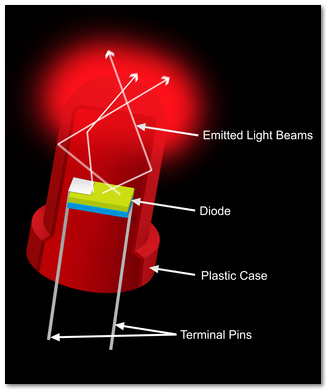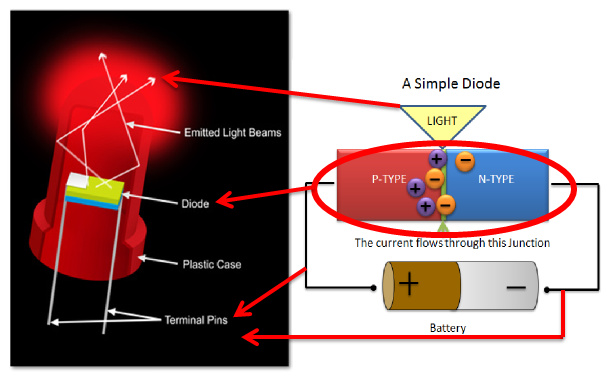Looking at the Inside of an LED
LEDs are fascinating lights aren’t they? It’s pretty cool that scientists have found a way to mix semiconductors in a way that will produce light. In the previous section (part 1 of the how LED grow lights work series) we talked about semiconductors, free electrons, and diodes. In this section we’ll take a look at the inside of a real LED and then we’ll see where the diode fits into the equation.

Note that most grow lights look a little bit different than this LED, but for learning purposes this picture works excellently.
In the last section we discussed what a diode is (pictured below). Remember that a diode is simply made up of two semiconductors (P-Type and N-Type). When attached to a battery (or some other form of charge) the electrons from the N-Type semiconductor race towards the P-Type electrons. The N-Type electrons end up falling in orbit and when an electron falls in orbit light is produced. This process is known as electroluminescence.
Putting it all Together

I’m pretty happy about this picture. Yes it’s simplistic, but I think it bridges the gap between what a diode is and how it fits into an actual LED grow light.
Note that diodes are sometimes called diode chips or just LED chips. Of course and LED chip can refer to the entire diode itself so things can get confusing when talking diodes and chips.
Also note that the LEDs that go on grow lights look a little bit different than the light pictured above. I’m still working on getting a better, close-up picture of one.
Random Tidbits
The terminal pins on an LED (also pictured above) are devices known as electrodes that can conduct electricity to the nonmetallic diode. The positively charged electrode on the left is known as the anode. The negative electrode on the right is known as the cathode.



You must be logged in to post a comment.